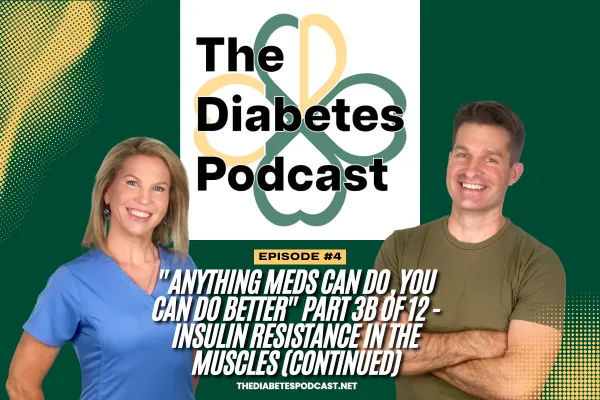
EP004 - Diabetes Dirty Dozen - Part 3B
Muscle Insulin Resistance: Why Metformin Helps—but Movement Wins
“Metformin decreased the incidence of type two diabetes by 31% compared to placebo… but lifestyle intervention reduced it by 58%.”
Welcome to part 2 of our chat on muscle insulin resistance! Today we’re digging into meds for muscle insulin resistance, what they do, and why simple movement after meals might be your most powerful tool. If you’ve ever felt blindsided by prediabetes or type 2 diabetes, you’re not alone. Let’s make this simple, practical, and doable—fifth-grade simple.
What Is Muscle Insulin Resistance?
Think of insulin as a manager trying to get sugar into your muscle cells.
Over time, the workers (your muscle cells) stop listening. That’s insulin resistance.
This doesn’t happen overnight. It can build for up to 20 years.
The good news: you can turn the ship around.
Where Do Meds Fit In?
The class of meds most used here: biguanides.
The most common name you’ve heard: metformin (also called Glucophage).
But before meds, the first line of defense—based on endocrine guidelines—is diet and exercise.
What Metformin Does (And Why People Use It)
Metformin is an insulin sensitizer: it helps your body use insulin better.
In the Diabetes Prevention Program (DPP), people with impaired glucose tolerance who took metformin had a 31% lower chance of developing type 2 diabetes than those on placebo.
That’s meaningful.
But It’s Not All Sunshine
Common side effects: nausea and diarrhea.
Real talk: many people report “inopportune diarrhea.” Planning your day around bathrooms is life-changing—in the wrong way.
Side effects are more likely when:
You start on the max dose right away (yikes).
Blood sugars are very high and metformin is pushed hard to avoid insulin.
Some people do great on metformin with no issues. Others stop it fast because of the bathroom problem.
Tips If You’re Prescribed Metformin
Start low, go slow:
Begin at 500 mg daily.
Increase every ~2 weeks (e.g., 500 → 1000 → 1500 → 2000 mg max).
Split dosing helps: often 1000 mg with breakfast and 1000 mg with supper.
Ask about extended-release (ER). It often reduces stomach issues.
Always take it with food.
Talk to your provider if side effects are rough. Don’t ghost your care team.
Lifestyle vs. Metformin: Which Works Better?
In the same DPP study:
Metformin reduced type 2 diabetes risk by 31%.
Lifestyle changes (diet + movement) reduced it by 58%.
Read that again. Lifestyle almost doubled the impact—without the bathroom drama.
Your Most Powerful Habit: Move After You Eat
Just 2–5 minutes of movement after meals helps:
Lower after-meal blood sugar spikes.
Reduce the triglyceride surge from your liver.
Why it works: Muscle contractions pull glucose into cells using a door called GLUT4—even without insulin.
Start small:
Pick your biggest meal.
Walk 2 minutes after it for 5–6 days.
Add a second meal the next week.
Then add the third.
No excuses. Walk in your kitchen, hallway, or living room if the weather’s bad. Barefoot is fine.
What Counts As Movement?
Walking is perfect to start.
Over time, add:
Light strength training (bodyweight, bands, dumbbells).
Short, frequent movement “snacks” during the day.
Building muscle improves muscle insulin resistance.
Food That Helps (Without Being Complicated)
Goal: clear fat from the liver, calm the spikes, and feed your muscles.
Choose:
Fiber-rich foods: beans, lentils, veggies, greens, berries, oats.
Lean proteins: fish, chicken, turkey, eggs, Greek yogurt, tofu.
Healthy fats: olive oil, avocado, nuts, seeds, omega-3s.
Limit:
Sugary drinks, desserts, pastries, candy.
Ultra-processed foods (soft, melt-in-your-mouth, very sweet).
Highly refined grains: many white breads, crackers, cookies.
“All white foods are bad” is too simple—and not true.
Onions, garlic, white peaches, cauliflower—these can be great.
The issue is often refining: when the bran and germ are stripped, you get softer, fast-digesting carbs that spike blood sugar.
A Quick Way to Spot Problem Foods
Does it dissolve in your mouth with almost no chewing (hello, hot donuts)?
Is it ultra-soft, very sweet, or from a box with a long ingredient list?
If yes, your blood sugar may not love it.
Why Your Liver Matters Here
Fatty liver and type 2 diabetes often show up together.
Good news: with better eating, fat can clear from your liver within weeks (as long as there’s no scarring).
What improves when liver fat drops:
HDL (“good”) cholesterol goes up.
Triglycerides go down.
LDL particles get larger and less dangerous.
You help this happen by:
Eating nutrient-dense foods.
Reducing ultra-processed foods.
Moving after meals.
Managing stress and getting better sleep.
Building muscle.
Staying consistent.
Stress, Sleep, and Consistency
Stress hormones can raise blood sugar.
Poor sleep makes cravings worse and insulin resistance higher.
Simple wins:
Aim for a steady bedtime and wake time.
Try 5–10 minutes of breathing or a short walk for stress.
Keep movement short and frequent so it’s easy to stick with.
The One-Thing Challenge
Take one step today.
Our pick: Walk 2 minutes after your biggest meal. Do it for a week.
Then build from there.
What’s Next on The Diabetes Podcast
Next time, we’re talking about increased lipolysis (fat breakdown), free fatty acids, and how they can stress the beta cells that make insulin over time.
Final Encouragement
Remission from type 2 and prediabetes is real.
Muscle insulin resistance can improve.
Medication can help, but movement after meals is your fast, safe, almost immediate win.
Need help making this your new normal? Contact us at [email protected]. Your healthiest chapter starts now. Take courage! You can do this—and we can help.
Disclaimer
The information in this blog post and podcast is for educational and informational purposes only. It is not medical advice, diagnosis, or treatment, and it does not replace a one-on-one relationship with your physician or qualified healthcare professional. Always talk with your doctor, pharmacist, or care team before starting, stopping, or changing any medication, supplement, exercise plan, or nutrition plan—especially if you have diabetes, prediabetes, heart, liver, or kidney conditions, or take prescription drugs like metformin or insulin.
Results vary from person to person. Examples, statistics, or studies are shared to educate, not to promise outcomes. Any discussion of medications, dosing, or side effects is general in nature and may not be appropriate for your specific situation. Do not ignore professional medical advice or delay seeking it because of something you read or heard here. If you think you are experiencing an emergency or severe side effects (such as persistent vomiting, severe diarrhea, signs of dehydration, allergic reaction, or symptoms of lactic acidosis), call your local emergency number or seek urgent care right away.
We strive for accuracy, but health information changes over time. We make no guarantees regarding completeness, timeliness, or suitability of the content and assume no liability for actions taken or not taken based on this material. Use of this content is at your own risk.
Links or references to third-party resources are provided for convenience and do not constitute endorsement. By reading, listening, or using this information, you agree to these terms and understand that you are responsible for your own health decisions in partnership with your licensed healthcare provider.

